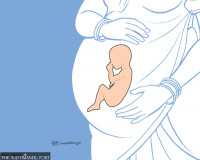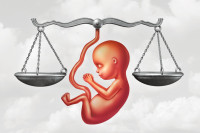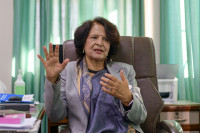Health
Nepal’s vaccination status
The country so far has received 3,148,000 doses and used 2,397,000 doses. Those who took the first dose of China’s Sinopharm vaccine will be administered the second dose from May 16 to May 25.
Post Report
Nepal government's poor communication system has left many Nepalis confused about its vaccination campaign, the status of the country’s stock of the doses and its plan—if it is planning—to procure more jabs against Covid-19. Back in January, Nepal became one of the first countries to launch its vaccination drive against the virus, even as some western countries were struggling. The country was seeing a dramatic decline in the number of new cases. The KP Sharma Oli government acted triumphant, as if it had already won the fight against the pandemic. Complacency, coupled with negligence, missteps and poor governance, then led to a sharp rise in the cases. The country has been overwhelmed by the pandemic. Nepal’s health system is buckling under pressure. Hospitals are turning away patients because they lack beds and oxygen. Nepal’s plan to procure millions of doses of vaccines is currently in a state of limbo.
Here’s everything you need to know about Nepal’s vaccination status.
When did Nepal launch its vaccination drive?
Nepal launched its vaccination drive on January 27 with the AstraZeneca type vaccine manufactured by India under the brand name of Covishield. The campaign was launched with the 1 million doses India had provided under grant assistance. At that time, the virus had claimed 2,017 lives and infected 270,092 across the country. Around 430,000 frontline workers–health workers, supporting staffers at health facilities, female community health volunteers, security personnel, sanitation workers, elderly people living in care homes, and prisoners–were listed as priority groups for vaccination. After the first round of the first phase was completed, the government said journalists and diplomatic staff could take the jabs.
When the government announced that the first phase was completed on March 5, as many as 438,000 had received their first dose.
When was the second phase?
From March 7 to March 15.
In February, the government decided to buy 2 million doses of vaccine directly from the Serum Institute of India, at $4 per dose. The delivery of the first consignment was swift, as 1 million doses arrived on February 21. The day the second phase of vaccination was started 348,000 doses of Covishield arrived in Nepal under the World Health Organisation-backed COVAX facility.
The government said all the citizens above 65 years of age would be inoculated. The public response was quite encouraging. In the second phase, around 1.3 million people were inoculated across the country.
What about the Chinese vaccines?
Nepal granted emergency use approval to Sinopharm’s Vero Cell (BBIBP-CorV) on February 15. China had promised 800,000 doses of the Sinopharm vaccine under grant assistance. The Chinese vaccine arrived in Nepal on March 29.
The second phase of vaccination drive had come to a halt as the Serum Institute had not supplied the remaining 1 million doses. After the arrival of the Chinese vaccine, the government said the inoculation campaign would resume from April 7.
Officials said those working in postal and telephone services, public transportation services, water supply and distribution, tourism sector—hotels and restaurants—production, sales and distribution of medicines, electricity supply, storage and transportation of consumer goods as well as health workers who missed out in the first phase of the vaccination drive that began on January 27 would be vaccinated with the Chinese jabs. Vaccines were administered from Dhulikhel Hospital, Barhabise Hospital of Sindhupalchok and district hospitals in Nuwakot, Rasuwa as well as several hospitals of Kathmandu, Lalitpur and Bhaktapur of the Kathmandu Valley.
The government has announced that the second dose of the Chinese vaccine will be administered from the districts from which the first dose was administered from May 16 to May 25. District health offices of respective districts will publish the list of immunisation centers soon, according to Dr Jhalak Gautam, chief of National Immunisation Programme.
After essential workers aged between 18 and 59 years were vaccinated, authorities said those aged 40 to 59 years who are willing to be inoculated can take the jabs from various designated hospitals. Mismanagement, however, led to crowding.
According to the Health Ministry, around 289,000 people were vaccinated with Chinese Sinopharm jabs before the inoculation campaign was halted.
How many people have completed their two doses?
Although 438,000 people had received the first dose (Covishield, according to official records), only around 370,000 took their booster dose during the second dose vaccination campaign from April 20 to April 24 across the country.
What’s the status of the vaccine stock?
Government officials say around 100,000 doses of Covishield are at hundreds of health facilities across the country, after some wastage. They say they have asked the health facilities to use the vaccines if their expiry date is nearing.
Similarly, around 500,000 doses of the Chinese vaccine are in the government’s stock, according to officials. Of them, 100,000 doses can be given to those who have not taken any shots. The remaining 400,000 doses will be given to those who took the first dose, as there is some wastage also. Officials have not calculated the wastage, yet.
When can people get the second dose of Chinese vaccine and from where?
The Health Ministry has said that the second dose of the Chinese vaccine will be administered from May 16 to May 24. This time the immunisation programme will be organised at the health facilities, which are not providing care to infected patients, as well as schools, colleges and other public buildings.
Respective health offices of Kathmandu, Bhaktapur, Lalitpur, Rasuwa, Nuwakot, Kavrepalanchok and Sindhupalchok will publish a list of immunisation centers “soon”, according to officials.
What about those 1.3 million people who took their first dose of Covishiled between March 7 and March 15?
The government does not know. These people need to take their booster dose between May 16 to May 29. The government has already said that under the present circumstances, bringing in more vaccines from India is almost impossible. After placing an order for 2 million doses, the government was planning to procure an additional 5 million doses from the Serum Institute. However, after cases started to rise, India put a hold on the export of Covishield. Serum has not supplied the remaining 1 million doses for which Nepal has already paid. Officials were expecting to receive some doses under the WHO-backed COVAX facility by the end of May, but they told the Post that they have been informed that the supply would be delayed. “The supply could be pushed further to June,” an official said.
What is the vaccine registration form?
The Health Ministry has prepared an online vaccine registration form, where members of the public have to update their details. Once people fill up this form, they will be permanently registered.
“It went up online on Wednesday,” asid Dr Jhalak Gautam, chief of National Immunisation Programme.
Officials said such registration would help authorities know the exact status of the immunisation programme. The government as of now does not have information about who all have taken the jabs. Filling the form would help the authorities to know who took the first dose and who missed the second dose. Since no details are available, authorities do not know who did not take the second shot and why. Like in the case of the first phase, though 438,000 took the first jab, only 370,000 took the booster dose. Authorities do not know who these people are and why they missed it.
Gautam, the chief of the immunisation programme, said there, however, were some technical issues on the registration website. “Registrations will resume soon after the glitch is fixed,” said Sharma. “Even if they don’t register, they will get the vaccine. The registration is for the government’s records.”






 9.12°C Kathmandu
9.12°C Kathmandu













